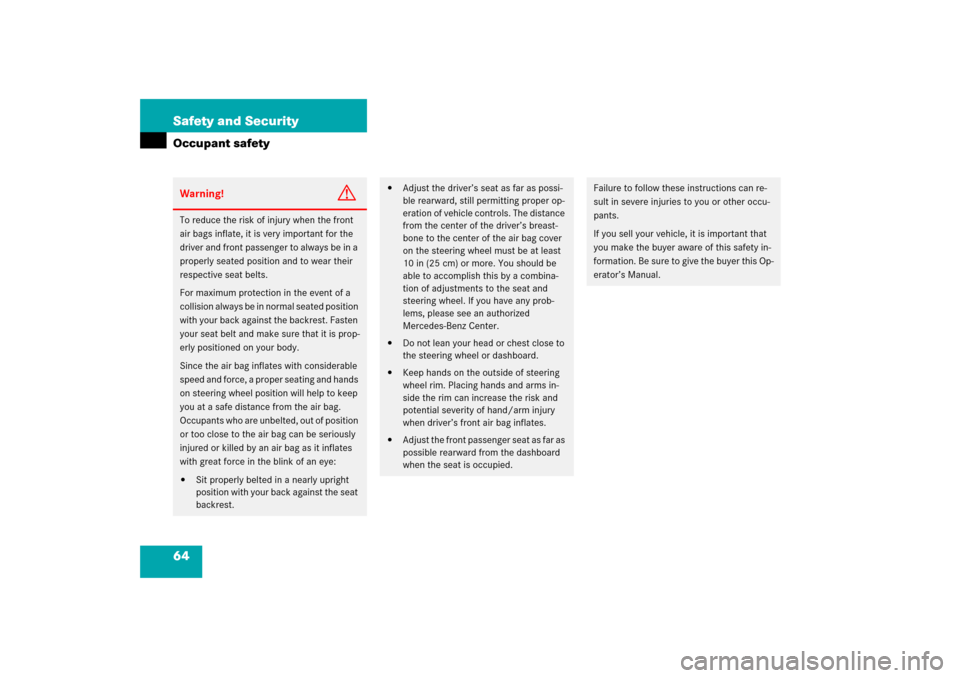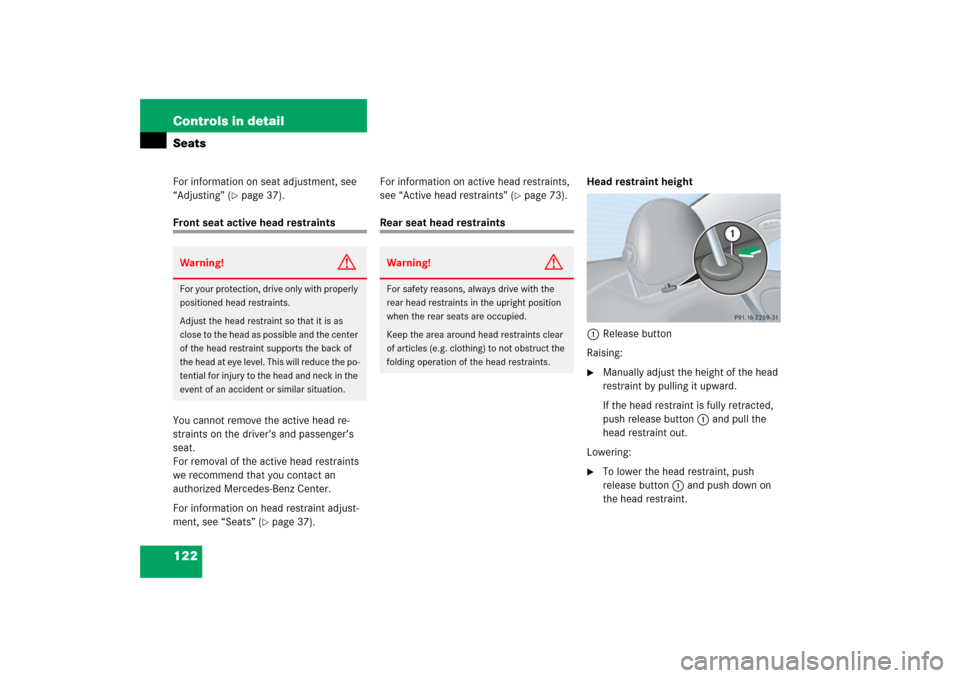Page 48 of 489

47 Getting started
Driving
�
With a smooth motion, pull the belt out
of the seat belt presenter.
�
Place the shoulder portion of the belt
across the top of your shoulder and the
lap portion across your hips.
�
Push latch plate1 into buckle3 until
it clicks.
�
If necessary, tighten the lap portion to
a snug fit by pulling shoulder portion
up.Proper use of seat belts
�
Do not twist the belt when fastening.
�
Adjust seat belt so that the shoulder
portion is located as close as possible
to the middle of the shoulder (it should
not touch the neck). Never pass the
shoulder portion of the belt under your
arm.
�
Position the lap belt as low as possible
on your hips (over hip joint) and not
across the abdomen.
�
Place the seat backrest in a nearly
upright position.
�
Never use a seat belt for more than one
person at a time.
�
Do not fasten a seat belt around a
person and another object at the same
time. When using a seat belt to secure
infant or toddler restraints or children
in booster seats, always follow the
child seat manufacturer’s instructions.
�
Check your seat belt periodically
during travel to make sure that it is
properly positioned.
�
Make sure that the seat belt is always
fitted snugly. Take special care of this
when wearing loose clothing.Warning!
G
Do not pass belts over sharp edges. They
could tear.
Do not allow the belt to get caught in the
door or in the seat adjustment mechanism.
This could damage the belt.
Never attempt to make modifications to
seat belts. This could impair the effective-
ness of the belts.
Do not bleach or dye seat belts as this may
severely weaken them. In a crash they may
not be able to provide adequate protection.
Damaged seat belts or belts that were highly
stressed in an accident must be replaced.
Contact an authorized Mercedes-Benz
Center.
Page 65 of 489

64 Safety and SecurityOccupant safetyWarning!
G
To reduce the risk of injury when the front
air bags inflate, it is very important for the
driver and front passenger to always be in a
properly seated position and to wear their
respective seat belts.
For maximum protection in the event of a
collision always be in normal seated position
with your back against the backrest. Fasten
your seat belt and make sure that it is prop-
erly positioned on your body.
Since the air bag inflates with considerable
speed and force, a proper seating and hands
on steering wheel position will help to keep
you at a safe distance from the air bag.
Occupants who are unbelted, out of position
or too close to the air bag can be seriously
injured or killed by an air bag as it inflates
with great force in the blink of an eye:�
Sit properly belted in a nearly upright
position with your back against the seat
backrest.
�
Adjust the driver’s seat as far as possi-
ble rearward, still permitting proper op-
eration of vehicle controls. The distance
from the center of the driver’s breast-
bone to the center of the air bag cover
on the steering wheel must be at least
10 in (25 cm) or more. You should be
able to accomplish this by a combina-
tion of adjustments to the seat and
steering wheel. If you have any prob-
lems, please see an authorized
Mercedes-Benz Center.
�
Do not lean your head or chest close to
the steering wheel or dashboard.
�
Keep hands on the outside of steering
wheel rim. Placing hands and arms in-
side the rim can increase the risk and
potential severity of hand/arm injury
when driver’s front air bag inflates.
�
Adjust the front passenger seat as far as
possible rearward from the dashboard
when the seat is occupied.
Failure to follow these instructions can re-
sult in severe injuries to you or other occu-
pants.
If you sell your vehicle, it is important that
you make the buyer aware of this safety in-
formation. Be sure to give the buyer this Op-
erator’s Manual.
Page 123 of 489

122 Controls in detailSeatsFor information on seat adjustment, see
“Adjusting” (
�page 37).
Front seat active head restraints
You cannot remove the active head re-
straints on the driver’s and passenger’s
seat.
For removal of the active head restraints
we recommend that you contact an
authorized Mercedes-Benz Center.
For information on head restraint adjust-
ment, see “Seats” (
�page 37).For information on active head restraints,
see “Active head restraints” (
�page 73).
Rear seat head restraintsHead restraint height
1Release button
Raising:
�
Manually adjust the height of the head
restraint by pulling it upward.
If the head restraint is fully retracted,
push release button1 and pull the
head restraint out.
Lowering:
�
To lower the head restraint, push
release button1 and push down on
the head restraint.
Warning!
G
For your protection, drive only with properly
positioned head restraints.
Adjust the head restraint so that it is as
close to the head as possible and the center
of the head restraint supports the back of
the head at eye level. This will reduce the po-
tential for injury to the head and neck in the
event of an accident or similar situation.
Warning!
G
For safety reasons, always drive with the
rear head restraints in the upright position
when the rear seats are occupied.
Keep the area around head restraints clear
of articles (e.g. clothing) to not obstruct the
folding operation of the head restraints.
Page 126 of 489
125 Controls in detailSeats
Multicontour seat*
The multicontour seat has a movable seat
cushion and inflatable air cushions built
into the backrest to provide additional
lumbar and side support.
The seat cushion movement, backrest
cushion height and curvature can be
continuously varied with switches on the
side of the seat after switching on ignition.
1Seat cushion depth
2Backrest bottom
3Backrest center
4Side bolster adjustment
�
Switch on ignition (
�page 36).Seat cushion depth
�
Adjust the seat cushion depth to the
length of your upper leg using
switch1.
Backrest contour
�
Adjust the contour of the backrest to
the desired position using switches2
and3.
Backrest side bolsters
�
Adjust the backrest side bolsters so
that they provide good lateral support
using switch4.iIf, after a period of time, the seat no
longer provides the desired contour,
then repeat the adjustment procedure.
Page 482 of 489

481 Index
Turn signal lamps (Bi-Xenon*) 416
Turn signal lamps (Halogen) 415
Reporting safety defects 18
Research Octane Number see RON
Reset button,
In instrument cluster 25, 140, 153
Residual heat and ventilation* see REST*
Residual heat utilization* see REST*
REST* 207, 465
Restraint system see
Children in the vehicle
Restraint system see SRS
Restraint systems 465
Reverse gear position 172
RFI see Run Flat Indicator
Rims 343, 445
Roadside Assistance 12, 282
RON 306, 465
Roof rack 262
Rubber and plastic parts, Cleaning 357
Run Flat Indicator 465
Run Flat Indicator (Canada only) 329S
Safety
Driving safety systems 87
Occupant 62
Reporting defects 18
Safety belts see Seat belts
Satellite radio* 220
Seat belts 69
Automatic comfort-fit feature 72
Children in the vehicle 74
Cleaning 358
ETD 72
Fastening 45
Force limiter 72
Message in display 396
Proper use of 47, 70
Safety guidelines 66
Telltale 25, 71, 366
Seating capacity 322
Seats, Multicontour* 125
Backrest contour 125
Backrest side bolsters 125
Cushion depth 125Seats, Power 37, 122
Active head restraints 73
Adjustment 38
Easy entry/exit feature 42
Heating* 126
Memory function 128, 130
Ventilation* 127
Seats, Rear bench seat 265
Securing cargo 267
Selector lever see Gear selector lever
Self-test
OCS 81
Tele Aid 280
Service and Warranty Booklet
Loss of 441
Service and warranty information 10
Service life, Tires 318
Service see Maintenance
Service System see
Maintenance service system
(U.S. vehicles) or
FSS (Canada vehicles)
Service, Parts 440